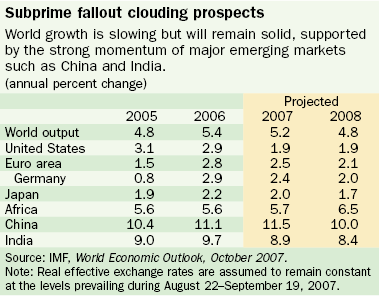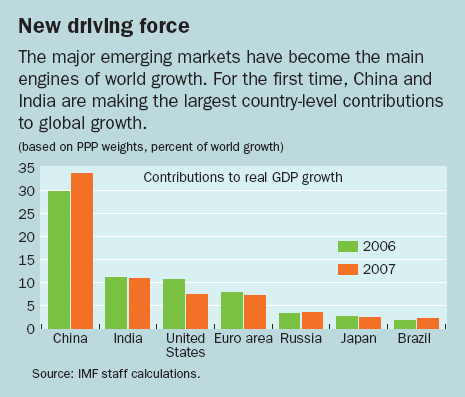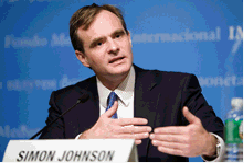
Typical street scene in Santa Ana, El Salvador. (Photo: iStock)
IMF Survey: IMF Forecasts Slower World Growth in 2008
October 17, 2007
- World growth to slow in 2008, but still expected to remain solid at 4¾ percent
- Major emerging markets have taken over as leading contributors to global growth
- U.S. economy expected to remain weak next year, with growth of 1.9 percent
World economic growth is expected to slow next year, with recent turbulence in financial markets triggered by the fallout from the U.S. subprime mortgage market clouding prospects, the IMF said in the October 2007 World Economic Outlook (WEO) released on October 17.

Optical fiber plant in Nanjing, China: Major emerging markets are now leading contributors to global growth (photo: Sean Yong/Reuters)
WORLD ECONOMIC OUTLOOK
IMF Chief Economist Simon Johnson told a press briefing that a benign financial environment had built up a sizeable "underbrush" of risky loans, relaxed lending standards, and high leverage in certain areas. When problems ignited in the U.S. subprime mortgage market, the fire "jumped" in somewhat surprising ways to other areas.
"In other words, at least three important `fire breaks'—that should have limited the impact of the crisis in U.S. subprime mortgages—did not hold," Johnson said. He stressed, however, that some important firebreaks did hold. "There was relatively little impact on U.S. investment grade corporate bonds. More broadly, the financial problems did not spread seriously to emerging market and developing countries."
Robust expansions
Before the turbulence erupted in August, the global economy had been expanding vigorously, with growth running above 5 percent in the first half of 2007, according to the WEO. China's economy gained further momentum, growing by 11½ percent. India also continued to grow very strongly at more than 9 percent, and Russia grew by almost 8 percent.
These three countries alone had accounted for one-half of global growth over the past year. Robust expansions also continued in other emerging market and developing economies, including low-income countries in Africa.
Rapid growth in the emerging markets counterbalanced continued moderate growth of about 2¼ percent in the United States in the first half of 2007, as the housing sector continued to exert considerable drag. Among the advanced economies, growth in the euro area and Japan slowed in the second quarter of 2007 after two quarters of strong gains.
Solid growth ahead despite turmoil
The IMF expects healthy growth to continue into 2008 (see table), with emerging market economies continuing to serve as the main growth engine of the world economy (see chart).

According to the latest forecast, global growth would slow from 5.2 percent in 2007 to 4.8 percent in 2008, down from the 5.4 percent rate registered in 2006. The largest downward revisions to growth are in the United States, and in countries where financial and trade spillovers from the United States are likely to be the largest.
In the United States, growth is now projected to remain at 1.9 percent in 2008, the same rate as in 2007 and a markdown of almost 1 percentage point compared to the IMF's previous projections. U.S. growth is down from 2.9 percent in 2006.
Ongoing difficulties in the mortgage market are expected to extend the decline in residential investment, while higher energy prices and weaker house prices are likely to dampen consumption spending, the IMF said. In the euro area, growth has been marked down to 2.1 percent in 2008, and in Japan it is now expected at 1.7 percent.

In the emerging markets, economies are expected to continue to expand strongly, although growth is expected to slow from the heady pace of the past two years. The Chinese economy will grow by about 10 percent in 2008, according to the IMF, and growth will also remain buoyant in other emerging markets.
Risks tilted to downside
The IMF's projections are based on the assumption that market liquidity is gradually restored in coming months (see "Market Turmoil Puts Focus on Transparency"). But there is still a distinct possibility that recent turbulent conditions could have a deeper effect on credit availability than envisaged by the IMF in its baseline scenario, with considerably greater macroeconomic impact.
Mortgage lenders are already tightening lending standards, and if financing becomes less readily available, a sharper downturn in housing markets, which look richly valued in some parts of the world, is a clear possibility. Not only would this affect consumption and residential investment spending, but as delinquencies rise it would also hurt the balance sheets of mortgage lenders themselves.

Johnson at WEO briefing: At least three important `fire breaks' to limit U.S. mortgage crisis impact did not hold (IMF photo)
Other risks are linked more specifically to the emerging markets. On the upside, the slowing in growth envisaged in the baseline projections in emerging Asia, particularly in China and India, may not materialize given the underlying strength of domestic demand.
Inflationary pressures
The main downside risk to emerging markets is that turbulence in global financial markets could disrupt capital flows to emerging markets and trigger problems in domestic markets. Countries in emerging Europe and in the Commonwealth of Independent States are particularly exposed because of their large current account deficits and reliance on bank-related inflows.
The IMF is also still concerned about inflationary pressures. While such concerns have taken a backseat in advanced economies since the recent bout of financial market turbulence, inflationary risks are more immediate in emerging market and developing countries. Here, rising food prices, dwindling spare capacity, continuing high oil prices, and still strong foreign exchange inflows may mean that monetary policy needs to tighten further to contain inflation pressures.
Global oil markets also remain very tight, and with spare capacity still limited, supply shocks or heightened geopolitical concerns could lead to further oil price spikes that could quickly translate into higher inflation.
Worrisome risk
Global imbalances also remain a worrisome downside risk, although there are some signs of moderation. The U.S. current account deficit is projected to decline only slightly to 5½ percent of GDP this year and next. And while the current account surpluses of oil producing countries are expected to come down as these countries ramp up spending, China's current account surplus remains very large.
Persistent, large global imbalances raise two principal concerns.
• the possibility of a disorderly depreciation of the U.S. dollar, which could have severe repercussions throughout global financial markets.
• sustained large trade imbalances, which could prompt rising protectionist pressures.
In sum, the global economy has faced a significant test in recent months. Nonetheless, generally sound fundamentals should keep the global economy on course. So while growth in the coming months will be affected by the aftermath of the financial turbulence, at this stage it does not appear the impact will be dramatic.
See related stories:
Biofuel Demand Pushes Up Food Prices
'Encouraging Signs' on Global Imbalances
Emerging Markets Main Engine of Growth


